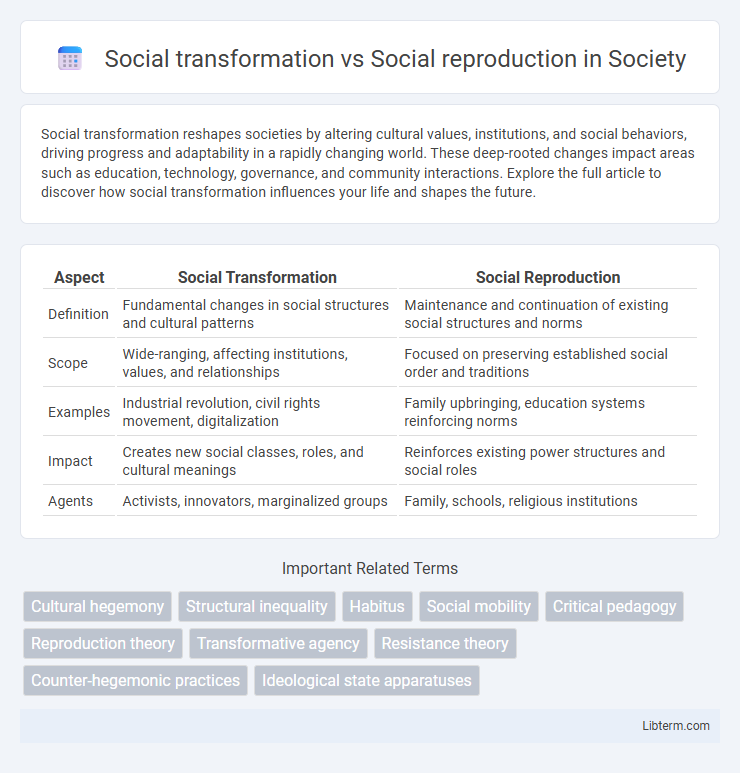Social transformation reshapes societies by altering cultural values, institutions, and social behaviors, driving progress and adaptability in a rapidly changing world. These deep-rooted changes impact areas such as education, technology, governance, and community interactions. Explore the full article to discover how social transformation influences your life and shapes the future.
Table of Comparison
| Aspect | Social Transformation | Social Reproduction |
|---|---|---|
| Definition | Fundamental changes in social structures and cultural patterns | Maintenance and continuation of existing social structures and norms |
| Scope | Wide-ranging, affecting institutions, values, and relationships | Focused on preserving established social order and traditions |
| Examples | Industrial revolution, civil rights movement, digitalization | Family upbringing, education systems reinforcing norms |
| Impact | Creates new social classes, roles, and cultural meanings | Reinforces existing power structures and social roles |
| Agents | Activists, innovators, marginalized groups | Family, schools, religious institutions |
Understanding Social Transformation
Social transformation involves fundamental changes in societal structures, norms, and power relations, leading to shifts in cultural, economic, and political systems over time. It contrasts with social reproduction, which maintains and perpetuates existing social orders and institutions through family, education, and socialization processes. Understanding social transformation requires analyzing factors such as technological innovation, social movements, policy reforms, and shifts in collective consciousness that drive progressive change in societies.
Defining Social Reproduction
Social reproduction refers to the processes through which societies maintain and perpetuate their social structures, values, and norms across generations, encompassing activities such as education, family upbringing, and cultural transmission. It ensures the continuity of social institutions and the stability of class relations by reproducing labor power and social roles. Unlike social transformation, which involves fundamental changes in social organization, social reproduction emphasizes the preservation and reinforcement of existing social patterns.
Historical Contexts: Transformation and Reproduction
Social transformation refers to profound, systemic changes in societal structures and cultural norms, often triggered by revolutions, industrialization, or shifts in political power throughout history. Social reproduction involves the maintenance and perpetuation of existing social orders, values, and inequalities across generations, frequently upheld through institutions like family, education, and legal systems. Historical contexts reveal how moments like the Industrial Revolution accelerated transformation, while traditions in feudal or caste systems exemplify persistent social reproduction.
Key Theories and Thinkers
Social transformation involves fundamental shifts in societal structures and cultural norms, emphasized by Karl Marx's conflict theory, which highlights changes driven by class struggles and economic factors. Max Weber's theories contribute to understanding social reproduction, focusing on how power, status, and bureaucracy maintain existing social orders across generations. Pierre Bourdieu's concept of cultural capital bridges these ideas by explaining how social reproduction occurs through education and habitus, perpetuating inequalities even amidst potential social transformations.
Mechanisms Driving Social Transformation
Mechanisms driving social transformation include technological innovation, shifts in economic structures, and changes in cultural norms that challenge existing power relations and social institutions. Social movements, policy reforms, and diffusion of new ideas facilitate the reorganization of social roles and collective identities, enabling societies to evolve beyond established patterns. Contrarily, social reproduction relies on the preservation of existing social structures through family traditions, educational systems, and institutional practices that reinforce continuity and stability.
Factors Sustaining Social Reproduction
Social reproduction is sustained by interrelated factors such as economic structures, cultural norms, and educational systems that perpetuate existing social hierarchies and labor divisions. Family roles and gender expectations reinforce the transmission of social values and resources across generations, maintaining class status and social identities. Institutional frameworks, including policies on welfare, housing, and labor markets, play a critical role in stabilizing social conditions and limiting disruptions to established social orders.
Education: Catalyst or Barrier?
Education functions as a catalyst for social transformation by equipping individuals with critical thinking skills and knowledge that challenge existing social norms and promote progressive change. Conversely, educational systems can act as barriers to social mobility through unequal access, reinforcing social reproduction by perpetuating class divisions and limiting opportunities for marginalized groups. The impact of education on society depends on its ability to foster inclusivity and critical consciousness rather than merely maintaining established hierarchies.
Case Studies in Social Change
Case studies in social change reveal contrasting dynamics between social transformation and social reproduction, where transformation involves fundamental shifts in societal structures, such as shifts observed during the Civil Rights Movement or the Arab Spring. Social reproduction focuses on the perpetuation of existing social norms and inequalities, evident in long-term caste systems in India or gender roles in traditional societies. Analyzing these cases highlights the mechanisms through which societies either evolve or maintain continuity across generations.
Implications for Policy and Society
Social transformation involves fundamental changes in cultural values, social institutions, and power structures, requiring policies that promote inclusivity, equity, and innovation to address systemic inequalities and foster social mobility. Social reproduction refers to the processes that maintain existing social structures and cultural norms, emphasizing the need for policies aimed at improving education, healthcare, and family support systems to sustain social stability. Understanding the balance between these dynamics enables policymakers to design interventions that both challenge entrenched disparities and support necessary societal continuity.
Future Directions: Bridging Transformation and Reproduction
Future directions in social theory emphasize integrating social transformation and social reproduction by fostering adaptive institutional frameworks that support both innovation and stability. Emphasizing interdisciplinary research, scholars aim to develop models that balance systemic change with the preservation of cultural and economic continuity. Policy-making increasingly focuses on creating inclusive environments where transformative social movements coexist with foundational reproductive processes to sustain societal resilience.
Social transformation Infographic

 libterm.com
libterm.com